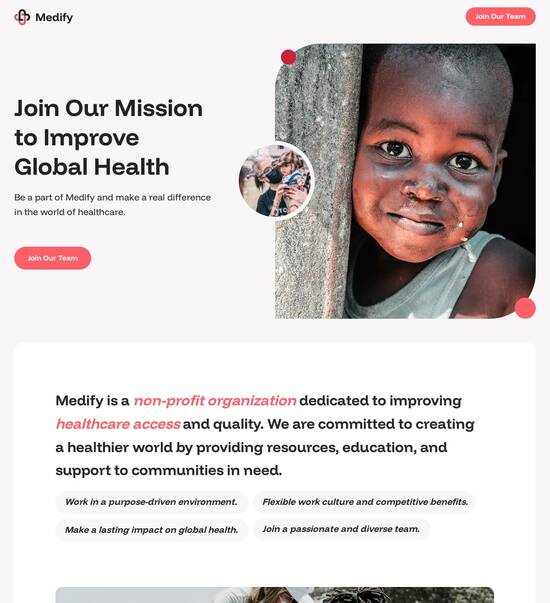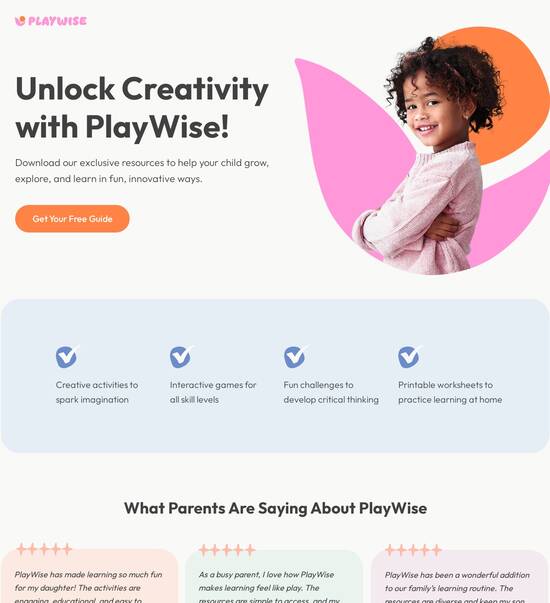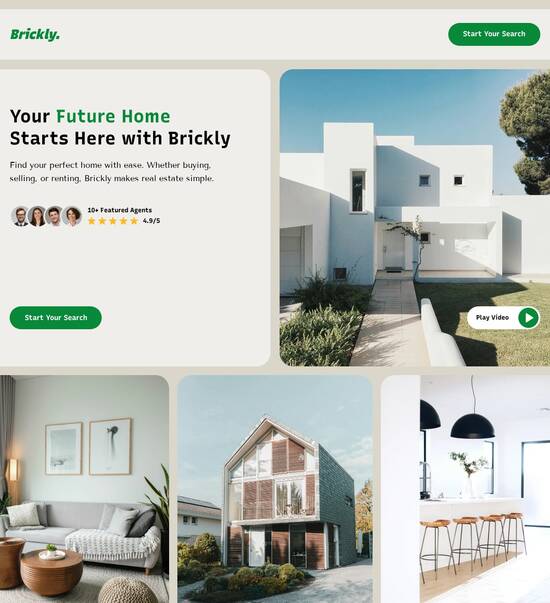
App page template for Full stack developers
Use TemplateAbout template
Attract clients and showcase your skills with style using our landing page templates for Full stack developers. Let's convert those visitors into clients!
Recommended templates

Easy to build without coding
With the intuitive drag-and-drop builder, anyone on your team can create high-converting pages without any knowledge of code or design. Make enhancements to your landing page with custom widgets using Javascript, HTML/CSS, or third-party scripts.

Multiple layouts for any industry and goal
Select from 500+ landing page layouts built to boost conversions across industry-specific scenarios. Customize them by adjusting fonts, adding images, and generating on-brand content with the AI assistant. Quickly scale with Instablocks® and Global Blocks that you can save, reuse, and update globally.

Loads fast and looks polished on any device
Every template is responsive, which means they present professionally on any device and load blazingly fast with our Thor Render Engine. You can also power them up with Google AMP technology to deliver an unparalleled mobile experience and drive higher conversions.

Robust analytics & experimentation
Get real-time updates and reporting across all your devices, showing the number of visitors, conversions, cost-per-visitor, and cost-per-lead. Launch AI-powered experiments, run A/B tests, and use heatmaps to analyze user behavior, then optimize your landing page to maximize conversions.







Easy to build without coding
With the intuitive drag-and-drop builder, anyone on your team can create high-converting pages without any knowledge of code or design. Make enhancements to your landing page with custom widgets using Javascript, HTML/CSS, or third-party scripts.
Multiple layouts for any industry and goal
Select from 500+ landing page layouts built to boost conversions across industry-specific scenarios. Customize them by adjusting fonts, adding images, and generating on-brand content with the AI assistant. Quickly scale with Instablocks® and Global Blocks that you can save, reuse, and update globally.
Loads fast and looks polished on any device
Every template is responsive, which means they present professionally on any device and load blazingly fast with our Thor Render Engine.
Robust analytics & experimentation
Get real-time updates and reporting across all your devices, showing the number of visitors, conversions, cost-per-visitor, and cost-per-lead. Launch AI-powered experiments, run A/B tests, and use heatmaps to analyze user behavior, then optimize your landing page to maximize conversions.
All the features you need to build lead-generating landing pages
Explore more featuresLearn how to build top-performing landing pages for any goal
FAQs
Leading the way in building high-performing landing pages





A powerful guide to using Instapage for high-converting landing pages in digital marketing
Creating effective landing pages is crucial for any digital marketing strategy. Instapage, as a robust landing page and conversion rate optimization (CRO) platform, provides marketers the tools they need to engage audiences effectively and optimize their campaigns. In this guide, we will walk you through the essential steps to leverage Instapage, from selecting the right template to personalizing user experiences that enhance conversions.
Understanding the importance of landing pages
Landing pages serve as powerful gateways for your digital marketing efforts. A well-designed landing page can significantly boost conversion rates by tailoring specific content to align with targeted traffic. By using tools like Instapage, marketers can harness high-converting templates and customize them to meet specific campaign objectives, enhancing both user engagement and ROI.
- Capture leads effectively: High-converting landing pages are designed to capture visitor information. Utilizing Instapage's lead generation elements can streamline this process, ensuring you don't miss potential leads.
- Optimize for mobile: With a significant amount of web traffic coming from mobile devices, leveraging Instapage’s mobile-responsive templates ensures accessibility, providing an optimal user experience on any device.
- A/B testing capabilities: Instapage’s built-in experimentation features allow you to run A/B tests, helping you learn what resonates best with your audience, leading to incremental improvements in performance.
Step 1: Choosing the right template
Start with Instapage’s extensive library of 100+ high-converting templates tailored to various industries such as Tech/SaaS and Financial Services. Whether you’re launching a new software product or promoting educational services, selecting a template that aligns with your specific vertical is essential.
Step 2: Personalizing the content
A great template is just the beginning. Personalization is key to increasing relevance and engagement. Breakdown your audience's segments and use dynamic text replacement to tailor your message to each group. This tactic can drive higher conversion rates by making each visitor feel that the content speaks directly to them.
- Use dynamic text replacement: Automatically alter keyword phrases on your landing pages to match visitor search queries, enhancing personalization and relevance to the user's entry point.
- Maintain consistency across ads: Align specific ads with their respective landing pages using Instapage's AdMaps feature, ensuring a seamless transition for users.
- Track user interactions: Leverage advanced analytics to understand user behavior, empowering you to refine your campaigns and enhance audience targeting.
Step 3: Utilizing optimization tools
Once your landing page is live, the work doesn't stop there. Use Instapage’s optimization tools such as heat maps and performance dashboards to gather insights on how visitors interact with your page. This data is invaluable for making informed adjustments that can lead to even better results.
- Heatmaps: Visualize user interactions on your pages to identify which elements are working and which areas may need adjustments.
- Performance metrics: Analyze key performance indicators such as traffic and conversion rates to evaluate your landing page's effectiveness.
- Feedback loops: Utilize real-time edits and feedback options to collaborate with your team efficiently and make necessary changes swiftly.
In conclusion, using Instapage to create landing pages can significantly enhance your marketing campaigns. By choosing the right template, personalizing content, and utilizing optimization tools, marketers can maximize their campaign's effectiveness and ROI.
Ready to transform your digital marketing strategy? Explore Instapage today and start crafting high-converting landing pages that engage your audience and drive results!
People also ask about App page template for Full stack developers
App page templates for full stack developers: A comprehensive guide
Understanding the role of app page templates in full stack development
App page templates are pre-designed layouts that serve as foundations for building web applications. They contain reusable sections for various functionalities, which developers can customize to suit specific needs. Within the scope of full stack development, these templates bridge the gap between front-end aesthetics and back-end functionalities, making them indispensable tools.
Full stack developers benefit greatly from page templates as they streamline the development process by providing a structured environment that allows for rapid prototyping and iteration. Furthermore, they enable developers to focus on implementing business logic and performance optimizations rather than starting from scratch. This layered approach reduces the time taken to deliver projects, which is critical in today’s fast-paced digital landscape.
Streamlining the development process by minimizing repetitive work.
Enhancing collaboration between developers and designers through shared visual references.
The components of effective app page templates
An effective app page template includes several core features that contribute to its overall functionality and usability. These features not only enhance the templating experience but also ensure a seamless user experience across devices. Among the core characteristics, responsive design is critical, allowing templates to adapt to various screen sizes, resulting in an optimal viewing experience.
Pre-built UI components simplify the process of creating user interfaces while ensuring that developers adhere to best practices. Customizability and scalability are equally essential; these features enable developers to modify templates to suit specific branding and project requirements without losing performance integrity. Together, these components make templates versatile assets in any developer's toolkit.
Responsive Design, ensuring optimal performance on all devices.
Pre-built UI Components that foster efficiency in design.
Customizability and Scalability for tailored solutions.
In addition to these core features, every effective app page template should include essential website components. These components encompass navigation menus that facilitate user journey, hero sections that grab attention, call-to-action buttons that drive actions, interactive forms, and crucial footer elements. An organized layout, enriched with these components, is paramount to generating user engagement.
Navigation Menus for easy site navigation.
Hero Sections to showcase key messages or value propositions.
Call-to-Action Buttons that guide users toward conversions.
Forms for User Interaction to collect user data.
Footer Elements that provide essential links and information.
Given the predominance of mobile internet access, highlighting mobile-first design principles in app page templates is becoming increasingly critical. This approach prioritizes mobile usability and performance, focusing on essential features that result in an efficient user experience. Techniques for implementing mobile-first design include utilizing fluid grids, flexible images, and media queries to adapt content effectively.
Navigating the developer's admin dashboard
The admin dashboard is a cornerstone feature that enhances the manageability of web applications. It grants administrators and developers oversight of various functionalities, including user management and analytics reporting. Properly designed dashboards provide a clear overview of site performance, user interactions, and crucial metrics that inform development strategies.
Through effective user management features, developers can control user accounts, permissions, and roles from a centralized location. This functionality not only streamlines user onboarding but also builds an organized framework for maintaining security across the application. Additionally, integrated analytics tools equip developers with the knowledge necessary to make data-driven improvements.
User Management for handling account access.
Analytics and Reporting Tools for site performance insights.
The admin dashboard also enhances collaboration between team members. Role assignments and permissions allow developers and designers to work on different aspects of the project simultaneously, creating a more efficient development cycle. Workflow integration between development and design teams promotes fluid communication, ensuring that project goals align and are met in a timely manner.
Innovative templates for seamless development
As technology evolves, so do the expectations surrounding app page templates. Innovative templates that incorporate features like drag-and-drop functionality set templates apart, allowing developers to arrange elements without extensive coding knowledge. This user-friendly approach simplifies the design process, making it accessible to a wider audience, fostering creativity, and minimizing bottlenecks in development workflows.
Moreover, integration with third-party solutions broadens the capabilities of app page templates. This encompasses tools such as payment gateways, analytics software, and marketing platforms, which enhance functionality and audience engagement. Different template variations tailored for use cases like landing pages, e-commerce product displays, and administrative dashboards cater to specific user needs, providing versatile solutions.
Landing Pages for Marketing Campaigns focused on lead generation.
E-commerce Product Pages simplified for online sales.
Blogging and Content Management Pages optimized for engagement.
Dashboard and Admin Panels for application management.
Enhancing web design with UI kits
UI kits are essential resources for web developers that serve to standardize design elements and streamline the design process. By providing a library of components, UI kits facilitate rapid development and ensure visual consistency throughout a web application. These kits often include common UI elements such as buttons, forms, and modals, which can be easily integrated into various templates.
Employing effective UI kits allows developers and designers to collaborate more efficiently, as they share a common understanding of design principles. This collective knowledge not only speeds up the design process but also fosters a unified brand identity across different applications and interfaces. The right UI kit can significantly elevate the visual appeal of a project, engaging users from the moment they interact with it.
Typography and Color Schemes that establish a brand identity.
Component Libraries for Common Elements facilitate design efficiency.
Icons and Imagery Guidelines that enhance usability.
Overcoming development challenges with template solutions
When building websites from scratch, developers often encounter various challenges that can hinder progress. Common pitfalls include time constraints that demand rapid development, as well as maintaining design consistency throughout the application. These issues can lead to frustration and burnout, impacting both productivity and project quality. This is where template solutions make a significant difference.
App page templates help mitigate these challenges by providing a structured framework that minimizes the time taken to complete a project. By using pre-designed layouts, developers can reduce cognitive overload and concentrate on enhancing the underlying functionalities. Consequently, templates simplify updates and maintenance, enabling teams to pivot in response to shifting project requirements seamlessly.
Reducing Development Time through pre-built solutions.
Minimizing Cognitive Overload for more efficient workflows.
Simplifying Updates and Maintenance with clear structures.
Best practices for utilizing app page templates
To maximize the effectiveness of app page templates, developers should adhere to several best practices. Customization guidelines are pivotal; while templates offer considerable functionality, it is crucial to balance these features with unique branding elements. This ensures that the final product does not resemble a one-size-fits-all solution, allowing businesses to present their distinct voice and image.
Avoiding template overuse is another practical guideline. Over-reliance on templates can lead to generic solutions that fail to engage users fully. It is essential for developers to apply innovation to customize templates and tailor them to specific project needs. Additionally, testing and optimizing templates is fundamental for performance; A/B testing can be employed to gauge user engagement while analytics tools can provide insights into template effectiveness.
Balancing Template Features with Unique Branding to stand apart.
Avoiding Template Overuse to maintain uniqueness.
Future trends in app page template development
The landscape of app page template development is continuously evolving. Anticipating shifts in user experience and design trends is becoming increasingly crucial as consumers expect more personalized and interactive experiences. This evolution is set to influence how templates are developed, focusing more on adaptability and customization capabilities that accommodate unique user preferences.
Artificial intelligence is anticipated to play a robust role in template customization. By automating routine design tasks and personalizing user experiences, AI can significantly enhance the effectiveness of app page templates. Developers will have greater opportunities to leverage AI-driven insights that can inform design decisions and predictive analytics, driving improved user engagement and satisfaction.
Anticipating Changes in User Experience and Design to stay ahead.
The Role of Artificial Intelligence in Template Customization needs exploration.
Case studies: Successful implementation of app page templates
Real-world examples of successful implementation of app page templates showcase the significant impact they can have across various industries. Startups have leveraged these templates for rapid growth, allowing them to launch MVPs (Minimum Viable Products) quickly while focusing on gathering user feedback. This approach has enabled many companies to confirm product-market fit before proceeding with extensive development.
Large enterprises have also benefited from templates, using them to streamline processes for internal applications. By implementing app page templates, these organizations have improved user satisfaction and increased conversion rates. Analyzing results and metrics from these implementations provides tangible proof of the advantage templates can offer, including noticeable boosts in user engagement and overall satisfaction.
How startups have leveraged templates for rapid growth.
Large enterprises’ strategies for internal applications enhance productivity.
Building the future: Combining creativity with technology
The fusion of creativity and technology is vital for bridging the gap between design and development. Encouraging a collaborative mindset among team members can lead to innovative solutions that push the boundaries of what templates can achieve. Techniques such as integrating feedback loops for iterative design not only facilitate better communication but also result in enhanced, user-centric applications.
Crafting unique solutions within a template-driven landscape requires a balance between utilizing established frameworks and fostering innovation. Developers play a crucial role in the evolution of templates by continuously adapting them to meet changing user needs and advancing technologies. By approaching template development with an eye for innovation, teams can thrive in an increasingly template-centric world.
Encouraging a Collaborative Mindset to enhance teamwork.
Integrating Feedback Loops for Iterative Design to refine projects.
Ready to skyrocket conversions?
Supercharge your ad campaigns with high-performing landing pages
Get started














